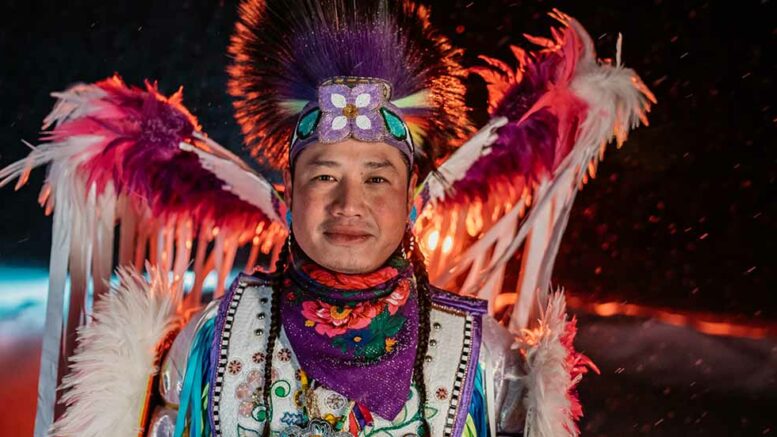By Chevi Rabbit, Local Journalism Initiative Reporter
(ANNews) – Patrick Mitsuing and his family are powwow community builders who call Central Alberta home. Most recently, Mitsuing has become internationally famous for his fancy dance performance at the 2023 Super Bowl; it was a huge milestone for his family.
Mitsuing is also a well-known figure in Central Alberta for his role in creating a healthy and vibrant powwow community in Red Deer.
The power powwow couple, Patrick and Marissa Mitsuing invested nearly a decade of community building with the City of Red Deer. They have created a social infrastructure for a healthy and positive powwow community.
It started about a decade ago, explained Mitsuing. “12 years ago, I set the intention when we first arrived in Red Deer. I said I’m going to have a powwow there as we drove by the Peavey Mart Centrium.”
In an interview with Alberta Native News, Patrick Mitsuing opened up about fleeing a violent neighborhood and seeking out a safer city area. He said it was by chance that the Mitsuing family heard about the safest places in Canada on the news.
“I was living in Saskatoon, in a bad neighbourhood,” said Mitsuing, and he had just heard about a murder and a drug bust that took place near his home. “At the time, I had my one-year-old, and I wanted to make a better life for my family.”
The news report said the safest places to live in Canada were two locations down east, which were too far; the closest place listed was Sylvan Lake, Alberta.
“We left on a whim,” said Mitsuing. “We didn’t know anybody, we just left.” The Mitsuing family arrived in Sylvan Lake.
Patrick instantly recognized the opportunity to serve a community that was being underserved when it came to Indigenous community activities. When they arrived in Red Deer, they discovered there hadn’t been a powwow in the city in nearly 20 years.
Coming from a traditional powwow family, Mitsuing had the talent and skills to educate and perform locally. He said that at first he started volunteering his time at local schools to guest speak about powwow dancing.
“I would call schools and ask if they needed a speaker or a dancer. I wasn’t getting paid. I just wanted to get myself out there, and sure enough, through word of month, I started getting requests to perform at the schools,” said Mitsuing.
He explained, “There was a group here called the Red Deer Aboriginal Dance group that was about to call it quits – we decided to get a group of people [who were] passionate about community, and we took over the group.
“We started creating powwow nights; then people started showing, 200 people, then 300 people… We were like, wow, people really like this.”
Mitsuing continued, “After that, we went to talk to the City of Red Deer and let them know we have this awesome programming going on, that’s not being supported, but we are bringing the community together, and so I asked for a bunch of money to support us.”
“Sure enough, the city started supporting us because of the families we served,” said Mitsuing.
The City of Red Deer was initially hesitant to give them a large amount of money because they didn’t understand what a powwow was, he added.
They needed to be educated about the value of Indigenous powwows and how they benefit a community.
“So, we had to do a lot of education in this area with the city, about what events like that would look like for the city,” said Mitsuing.
Eventually the city bought in and started financially investing in their group and they created Red Deer’s 1st Annual Red Deer International Powwow (RDIP) and an award-winning Powwow exhibit which they partner with Red Deer Museum + Art Gallery (MAG) to showcase traditional powwow regalia at MAG.
Mitsuing gives credit to his mentors who have helped mold his vision of creating a healthy and vibrant powwow community in Central Alberta.
“I have to give credit to Don Speidel from the Saskatoon Public Schools’ Division and Manito Ahbee festival,” he said.
“I gave these people tobacco and asked how I run a powwow; that tobacco was so powerful. So I got a university education by just sitting and conversing with people, and they gave me their sponsorship package, budget, and everything I needed to create a powwow.”
“What we have created is growing into something awesome,” continued Mitsuing. “It was the beginning of doing larger events, Truth and Reconciliation Days and full-on powwows.
“I think overall, it was just our love of serving the community and doing selflessly, and we just wanted to serve this market.”
Mitsuing shares how Powwow Times was initially an online platform to stay connected to society, culture and showcase Indigenous culture and powwow through various social media platforms.
He said, “Powwow Times was me going out and creating content. It was a way to stay connected to my culture; I was recording the powwow songs, meeting singers, recording the stories, hearing the elders, and hearing the stories around the dancing… Sitting with elders and going to ceremonies started connecting me.
“I started getting into online marketing and amazon affiliate marketing products online too.”
This is where he came up with combining online affiliate marketing with offering online powwow programming.
“I thought I could name it like New York Times, LA Times, and then I thought… Powwow Times. That sounded cool,” said Mitsuing.
From an idea to reality, Powwow Times is now a large online media site for Indigenous Culture, Song, and Dance. “Our mandate is revitalizing the Indigenous language and promoting healthy living through Indigenous culture and decolonization.”



His wifes name is Marissa, not Melissa.
Thank you – it’s corrected now.
Awesome write up, very informative, enlightening and inspiring. That’s what you get when you collaborate and speak for yourself and your family…